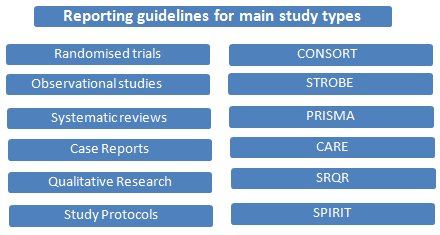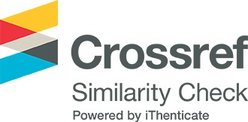
ISSN (Print): 2349-5987
ISSN (Online): 2348-8336
Author Instructions
TYPES OF MANUSCRIPTS
Manuscripts submitted can be
- Original articles
- Systematic reviews
- Case reports
- Study protocols
Original articles: Full lengths of original research or short reports of data from original research work are considered.
Systematic reviews: In-depth, comprehensive reviews in physiotherapy and related fields are considered.
Case reports: New clinical observations and novel Physiotherapy treatment will be considered for publication.
Reporting Guidelines
IJPHY reporting guidelines are based on guidelines given by the EQUATOR Network and the NLM's Research Reporting Guidelines and Initiatives.

Further Reading Reporting guidelines for main study types
MANUSCRIPT PREPARATION
Manuscripts of original research should include an introduction, methods, results, and discussion sections. Articles often need subheadings within these sections to further their content. Manuscripts of Case reports may be less structured.
The following general requirements are required for reporting within sections of all study designs and manuscript formats.
- Title page
- Abstract
- Introduction
- Methods
- Results
- Discussion
- Conclusion
- Acknowledgment
- Tables
- Illustrations
- References
Title page
General information about the article and its author should be presented on the title page. Article title – Title should provide a complete description of the article, information about the study design in case of experimental studies can be included in the title. Author’s information must be provided on the title page, which should include the author and contributing authors name and working address. Principle authors email address should be provided. Source of support – the authors are advised to disclose the source of support, which includes grants, equipment, and other support that facilitated the conduct of the study. Disclaimer – The author should provide a statement of disclaiming that the views expressed in the article are his/her own and not the funders/institutions.
Abstract
The abstract should not exceed more than 250 words; Abstract should provide the background, methods, results, and conclusion. References should not be presented in the abstract. Authors need to ensure that their abstract accurately reflects the content of the article because abstracts are the only substantive portions of the articles that are available in many electronic databases and the only portion readers read. The authors need to provide clinical trial registration number if the study is registered. IJPHY will publish the clinical trial registration number after the abstract.
Keywords
5 to 6 key terms representing the main content of the manuscript can be given, which are frequently used in the manuscript.
Introduction
Author Should Provide the background of the study, state the specific purpose or study objective, and cite only references from previous studies but should not include data or conclusions from work being reported.
Methods
The method of study should clearly explain why and how the study has been conducted. The section should include only information that was available at the time of the plan or protocol for the study was being written. The author should state the selection of participants, eligibility and exclusive criteria, and source of population, Objectives of the study, outcome measures, and procedure. Provide references to established methods and give the description of new or modified methods and give the reason for using them if ever so. Describe statistical methods, if possible, quantify findings and present them with appropriate indicators of measurement errors. Define statistical terms, abbreviations, and symbols. Specify the statistical software package used for the study and versions used.
Results
The authors are advised to summarize the most important findings first and to avoid the repetition of results in text, tables, and figures. Results should be in sequence with the tables and figures used. Specify the statistical significance of each finding.
Discussion and conclusion
In the discussion section, new and important aspects of the study should be emphasized. Experimental studies should begin by summarizing the main findings, then explore possible mechanisms or explanations for these findings, compare and contrast the results of other relevant studies. State the limitations of the study and explore the implications of findings for future research and clinical practice. Final Conclusion should be clear and supported by the data.
Tables and Graphs
Number tables and Graphs consecutively in the order of their first citation in the text and supply a title for each. eg., Table 1, or Graph 1. The title of the table/ graph should be short but self-explanatory. The author should place explanatory matter at the footnotes and not in the heading. If you use data from another published or unpublished source, obtain permission, and acknowledge that source fully.
Illustrations
Digital images of manuscript illustrations should be submitted in JPEG, PNG, TIFF, BMP formats. For X-ray films, scans, and other diagnostic images, as well as pictures of exercises, send high-resolution photographic image files. Photographs should be numbered consecutively according to the order in which they have been cited in the text. Eg. Figure 1. If a picture has been published previously, acknowledge the source and submit written permission from the copyright holder to reproduce it.
Abbreviations or symbols:
Please elaborate on the standard abbreviation used in the manuscript. Try to avoid using abbreviations or symbols in the title of the manuscript.
Acknowledgment
Authors are encouraged to acknowledge the contributors in the preparation of manuscript from conception to the final drafting of the manuscript.
References
References must be serially numbered and should be arranged in increasing order of number quoted in the text. References should be quoted in the text at the end of the sentence as Superscript. E.g...Institution 1.
1. Standard Journal Article:
References should follow the following sequence
- The author's name must come first, list until six authors, more than six authors followed by et al.
- Reference Title
- Reference Journal
- Year of Publication
- Volume Number
- Issue Number in Brackets
- Page Numbers
Example: Uhl RL, Roberts TT, Papaliodis DN, Mulligan MT, Dubin AH. Management of chronic musculoskeletal pain. J Am Acad Orthop Surg. 2014; 22(2):101-10.
1. Organization as Author
Reference can have an organization name instead of author name if the organization possesses the authorship.
Example: Diabetes Prevention Program Research Group. Hypertension, insulin, and proinsulin in participants with impaired glucose tolerance. Hypertension. 2002; 40(5):679-86.
2. Books and other Monographs :
In case Authors use a reference from books, they should follow the following sequence
- Authors Name
- Book Name
- Edition Number
- Year of Publication
Example: Susan B. O’ Sullivan. Thomas J. Schmitz. Physical Rehabilitation. 5th ed; 2006.
The commonly cited types of references are shown here, for other types of references such as conference papers, dissertations, newspaper items please refer to ICMJE Guidelines (http://www.icmje.org or (http://www.nlm.nih.gov/bsd/uniform_requirements.html).
Authors should provide direct references to the original research sources whenever possible, references of review articles do not always reflect original work accurately.
Do not use a conference abstract as references; they can be cited in the text but not to be used as footnotes.
References to papers accepted but not yet published should be designated as “in the press” or “forthcoming.”
Information from manuscripts submitted but not accepted should be cited in the text as “unpublished observations” with written permission from the source.
Authors are responsible for minimizing reference errors by using either an electronic bibliographic source such as Pubmed or print sources from sources. Authors can identify retracted articles in MEDLINE by searching Pubmed for “retracted publication (Publication type),” or by going directly to Pubmed list of retracted publications (www.ncbi.nlm.nih.gov/PubMed?term=retracted+publication+(Publication type).
Language
All the manuscripts should be submitted in clear and concise English. As a reference for spelling and hyphenation, the Oxford English dictionary should be used. The authors are advised to check all the grammatical mistakes before submission.
General Guidelines
- Please use Calibri font size 12 for the content of the manuscript and Constantia font size 14 for the title of the manuscript.
- Do not break words at the ends of lines.
- Do not use underlining.
- Use the TAB key, not the spacebar when indenting paragraphs or separating columns in tables.
- Leave the right-hand margin unjustified.
Please supply manuscripts as editable text files (Preferably Microsoft Word documents), and make sure that the manuscript file is anonymized as the journal applies a double-blind peer-review process.
Open access
All content published in IJPHY is made freely available online to all under an Open Access model. By the definition of the Budapest Open Access Initiative, all content published by the IJPHY is made free to users without any subscription or other charges. Users are permitted to read, download, copy, distribute, print, search, or link to the full text of these articles, or use them for any other lawful, non-commercial purpose.
Licensing Policy
The International Journal of physiotherapy is in favor of Open Access policies, and we will be licensing the manuscripts of the IJPHY with the Creative Commons (CC) BY-NC 4.0. The IJPHY allows readers to read, download, print, search, or share to the research data for the non-commercial purpose.
Copyright Policy
Copyright on an open-access article in a journal published by IJPHY is retained by the author(s).
Authors also grant any third party the right to use the article freely for non-commercial purpose as long as its integrity is maintained and its original authors, citation details, and publisher are identified.
License agreement
In submitting an article to International Journal of Physiotherapy (IJPHY), I certify that;
- I am authorized by my co-authors to enter into these arrangements.
- I warrant, on behalf of myself and my co-authors, that:
- the article is original, has not been formally published in any other peer-reviewed journal, is not under consideration by any other journal and does not infringe any existing copyright or any other third party rights;
- I am/we are the sole author(s) of the article. The article contains nothing unlawful, libelous, or which would, if published, constitute a breach of contract or confidence or commitment given to secrecy;
- I/we have taken due care to ensure the integrity of the article. To my/our - and currently accepted scientific - knowledge all statements contained in it purporting to be facts are true and any formula or instruction contained in the article will not if followed accurately, cause any injury, illness or damage to the user.
- I and all co-authors agree that the article if editorially accepted for publication, shall be licensed under the Creative Commons Attribution-Non-commercial 4.0 International License.
Plagiarism policy
Plagiarism software: All the submitted articles initially screened with 
A specific process is followed to manage a case of plagiarism. The IJPHY follows the guidelines contained in the Committee on Publication Ethics (COPE) flowcharts (http://publicationethics.org/resources/flowcharts):
In the case of suspected plagiarism in a published article:
- The person who advised us of the situation is informed about the process to be followed.
- The articles are compared to check the degree of copying.
- All Editors of the IJPHY are informed and asked for their comments.
- The corresponding author of the article in question is contacted with documentary evidence of the case of plagiarism and is asked for a response.
- If the authors are found guilty of plagiarism
- The editor of the journal in which the original plagiarized article was published and the authors of the plagiarized article are informed
- The IJPHY publishes an official retraction of the paper
- The online version of the article is withdrawn
- The IJPHY will not publish any article by any of the authors concerned for three years.
For more information related to plagiarism kindly contact plagiarism.ijphy@ijphy.com
Rejection Appeals
Authors have the right to appeal to editorial decisions. Appeals should be sent via e-mail to the Editor at editor@ijphy.com with a letter of appeal giving detailed explanations along with concise supporting arguments to substantiate the request. Appeals are then sent to a member of the Editorial Board for consideration. If successful, an appeal can lead to the article’s review being resumed, and the article may ultimately be published following any revisions the Board feels are necessary. However, if the appeal is rejected, then the original rejection decision is to consider. Please note, we must receive your appeal within 14 calendar days.
Retraction Guidelines: International Journal of Physiotherapy follows the COPE Retraction Guidelines.
Privacy Policy
The personal information collected from the visitors of our website, including their identity, remains confidential. We respect the law(s) on confidentiality applicable to this website (India), and we will never pass on these data to any third party unless required by law. Currently, we are using Google Analytics to analyze the audience of the website and improve our content. No personal information is collected from Google Analytics. For further information on the privacy policy concerning Google Analytics, please go here, http://www.google.com/analytics/learn/privacy.html"
Declaration: 'The information provided on [www.ijphy.com] is designed to complement, not replace, the relationship between a patient and his/her own physician.'


 This work is licensed under a
This work is licensed under a